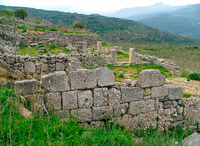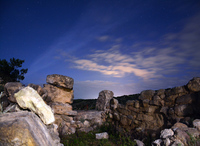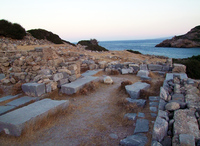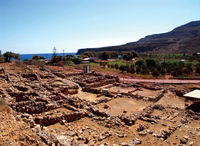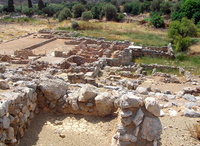The extremely rich and bright past of the region is certified by the many extendent archeological excavations and historical researches conducted by Greek and foreign researchers the last 100 years and on, and this fact is noted by the unforgettable Melina Merkouri. When she was the minister of culture in 1984, she performed the opening of the archeological museum of Sitia. Then, she said: "Sitia is one of the most priviledged places. Not only in terms of natural beauty but also in terms of history and culture. Few other places of the Greek land encompass within their borders so many signs of a bright. Eighty (80) archeological sites have been excavated in the region and more than a hundred (100) have been traced and wait to be excavated to enrich your wealth and pride". Indeed, the Sitia province is one of regions of Greece and of the whole world with a large number of antiquities within its borders, with archeological sites such as: The Minoan palace of Zakros, the Minoan town of Palekastro, the Minoan settlements-naval centers of Mohlos and Psyra, the Minoan cemetary of Aghia Fotia, the Minoan palace and settlement of Petra, the Minoan villas in Sitia, in Zou, in Pano Zakros, Achladia, Aghios Georgios, Makry Gialos, the residence Hamezi, the eteocretan Praissos, the Doric Itanos, the Hellenistic settlements of Trypiti and Xerocambo, the Roman Lefki (koufonisi) the medieval settlement of Voila, the Kazarma fortresses of Sitia, the Venetian villa in Etia, Liopetro, Monte Forte, ect; the monasteries of Toplou, Kapsa and Faneromeni, Byzantine churches, frescoes and icons, historical sites, folk architecture, traditional fountains, neo-classic houses, watermills, windmills, farms, and many more monuments of the local, national and global cultural heritage.
The Palace and the Minoan Settlement of Zakros
The first excavation in Kato Zakros was performed by the British D. Hogarth, in 1901. Then, the remains of a Minoan settlement came to the surface, indicating a flourished society. The most important of Hogarth's findings were the about 300 clay stamps on coins, indicating some sort of bureaucratic system of control or a number of commercial affairs. Some of these stamps originate from Knossos, something that indicates the close relationship of Knossos and Zakros, at least during the 15th century BC. In 1962, the Ephore of Cretan Antiquities N. Platon started a new excavation in the valley of Kato Zakros. The Greek archeologist was convinced that this position was "hiding" something more important than a "naval settlement", as it seemed to be the center of a culture, recognized by the ceramic products of the wider region. The excavation results were indeed impressive. The excavations revealed a Minoan palace and a settlement surrounding it, dispersed over the slopes of the two hills of the valley. Important findings came to light during the research of the Minoan tombs, most of which were "sheltered" in natural caves, in the gorge of Zakros -that after the findings was renamed as "the gorge of the dead" ("faraghi ton nekron") - but also in other positions, such as in "Mavro Aulaki" southeast from the gulf and "Spiliara", on the north slope of the valley. The palace of Zakros - as it is preserved today- was constructed during the 16th century BC. It is possible that it replaced an older public building, as indicated by the remains found under the east wing of the palace. Only at this spot it was possible to further excavate, since agricultural acitivity during the 20th century -and before the excavations- had totally destroyed this part of the palace. In terms of architecture, the palace of Zakros has several similarities with the larger palace of Knossos. In Zakrosl like in Knossos, the west wing (the section of the construction west from the central yard) accommodated the chambers of the shrine: the main shrine, next to a ritual room that A. Evans named "Lustral Basin", the treasury of the ritual objects and the majestic chambers of the rituals and the feasts, which in the case of Zakros were located on the ground floor. The placement of the main spaces of storage of agricultural products, of the palace treasury and of other spaces of processing valuable materials at the west wing, reaffirms the theory that the economic management of the Minoan state was in the hands of a powerful ministry. The east wing, like in Knossos, was probably used as the "accommodation area". The other two wings seem to have been of secondary importance. Laboratories were probably located at the south wing, as in some of the chambers valuable processed, unprocessed or semi-processed materials have been found (such as marble, crystals, ivory, ect). At the north wing there was another "Lustral Basin" which was probably connected with the entrance of visitors in the palace. The central gate of the palace was also the end of a cental road leading to the Minoan port. The close relationship and the similarities between Zakros and Knossos might lead to the conclusion that the latter was the metropolis of the former. Most of the buildings that form the Minoan settlement were probably built at the same time as the palace. Many of the buildings have "copied" architecture styles from the palace. Almost all the buildings had two floors with one or two stairways connecting the chambers of the two floors. The study of the ceramics had led to the conclusion that the settlement and the palace of Zakros were completely destroyed in 1450 BC. The destruction was probably caused by some natural disaster (an earthquake or the eruption of the volcano of Thira), as it was deserted for a long time and the palace was never re-constructed. Parts of the settlement were later re-inhabited for a short period of time (1400 -1300 BC), but since then the area never managed to re-establish its old glory.
The Minoan Villa of Pano Zakros
The Minoan villa of Pano Zakros was studied by N. Platonas, with the aid of his then associates, Giannis and Efi Sakellaraki, in the years of 1965 and 1966. The chambers of the ground floor include mainly production and storage spaces of agricultural products. One of the chambers accommodated one of the most articulate Minoan wine press, with two press basins and vessels to collect the product. Next to the wine press, a spacious storage room was found, along with six large tubs. One of the tubs beared a Linear A inscription, that started with the ideogram of the wine.
The Minoan town of Palekastro
At the beach of Palekastro, in the position of Russolakos, a great and big town of the Minoan period was excavated. It flourished during the post-Minoan period but some remains date back to the pre-Minoan period and the mid-Minoan period, mainly tombs with numerous bones very well preserved. The anthropologists that studied the bones found important information on the body structure of the Minoans, who reportedly had an average body length of 1.60 for men and 1.50 for women. A central road connects with 4 other roads that divide the town in 9 districts. The houses that face the central road had imposing fronts, while a complete drainage system was functioning in all the districts. In the district B, among others, there was a chamber-manor with 4 lines of columns and a kitchen, a "Lustral Basin", a well, a home shrine, a bath, and an oil storage room, while in other spaces there was an oil press. Many vessels, vases, lamps, ect were also found. Chamber-manor were also found in other districts, while in one district a wine press was found. In another district, the famous in antiquity shrine of Diktaios Zeus was found. At this shrine, Zeus was worshipped until the Roman period. The pieces of a plate where the hymn of Zeus Diktaios were also found; it is the first hymn to a deity in the ancient world and it is a hymn to peace and life. In the same space the pieces of an ivory figurine, "the masterpiece" of the Minoan civilization as it has been characterized, were discovered and are exhibited at the archeological museum of Sitia. Human activity in the Minoan town of Palekastro suddenly seized, as it happened in Zakros and in other towns of Crete in about 1500 BC, after the horrific eruption of the volcano of Thira.
The hymn to Diktaios Zeus.
Oh! Great Kouros, I salute you,
I salute you son of Cronous, master of the cosmos.
You, which came this spring again, here in Dikte
surrounded by the gods of vegetation;
Come with us, come in delecation
For our songs and melodies
For you we play, with harps and flutes
We laud you Zeus, around your adorned altar.
Oh! Great Kouros, I salute you,
I salute you son of Cronous, master of the cosmos.
Come with us, because it was here,
When your shield-bearing guards, the Kourites
Hided you and saved you
Rhythmically beating their feet,
When they took you from your mother Rhea.
Oh! Great Kouros, I salute you,
I salute you son of Cronous, master of the cosmos.
Come with us, you, star of the fair dawn
Oh! Great Kouros, I salute you,
I salute you son of Cronous, master of the cosmos.
And those times were fructuous and justice was the reigning amongst the people.
And all the creatures of the earth by the prosperous Peace were governed
Oh! Great Kouros, I salute you,
I salute you son of Cronous, master of the cosmos.
Come again, this spring with us
And dance, dance
And make the earth fertile
So that our jars are full
And our herds give wool like silk
And our grains are fecund
And our beehives bristling with honey
Oh! Great Kouros, I salute you,
I salute you son of Cronous, master of the cosmos.
Dance, dance and leap with joy and come with us, come and enliven the creation
Come and guard upon our cities
Protect our ocean crossing ships
Protect our young men
Uphold and protect our just laws
The above poem is a translation from the ancient Kouritic hymn found on epigram. Its many fragments were found dispersed close to the ruins of the Dictaean sanctuary in Palaecastro of Siteia. The big grey stone plaque bears text in both sides (one of the side contains several mistakes). Nevertheless, it was possible to combine the two texts and reveal the whole poem.
This hymn was sung by naked shield bearing young men that were representing the Kourites, the young men who protected and fostered the divine infant, the young Zeus. It is an epiclesis for the yearly revival of the young god, for a rich harvest and the weal of their live-stock. The hymn was part of initiation ceremonies during the transition of boys from adolescence to adulthood in order for them to enter to the class of “perfect” citizens.
Archaeological Park of Petra
Petra is a traditional settlement, 1 km east of Sitia. A small tower from the Venetian period can be found there. It bears the name "house of Kornaros" and belonged to the homonym family. On the hill over the tower, a small palace and a settlement have been brought to light by recent excavations. The rooms of the palace were luxuriously adorned and its walls painted with bright colours. Many pots, vases and epigrams of Linear A and B were found as well. Under the road of the contemporary settlement cyclopean fortifications were found, while in the fringes port installations were also found. In the adjacent hill "head of Petras" (east of the palace towards the sea) a Neolithic settlement is being excavated. Recently, the settlement of Petras has been transformed into an important archaeological park that is worth visiting during the summer months.
Koufonisi
The ancient name of the island was Lefki and it played an important role in the Hellenistic and Roman history of Eastern Crete. Its citizens were mainly fishermen and laver makers. The art of laver processing was known in the area since the prehistoric times as can be seen by the processed laver shells found in Minoan settlements. The laver trade was very lucrative. In 1975 in the same area, N. P. Papadakis excavated a Hellenistic theater with a capacity of 1000 spectators. The orchestra was semicircular and its corridors were vaulted. The second most important edifice found was the public bath house dating from the 1st century A.D. In the ancient Lefki settlement that is located close to the theatre, several houses operating as laver processing laboratories were also found. A mansion with numerous rooms, mosaics and colourful walls was also found. All findings, such as figurines, stone and metal vases are kept in the Archaeological Museum of Sitia. In the top of a hill, around 2 km from the settlement, the ruins of an ancient temple were also found, along with two remaining pieces from a colossal sitting statue. The water-supply system consisted of three built aqueducts bringing water from a spring on the top of the hill to the centre of the settlement. It seems that the whole area was violently destroyed during the 4th cent. A.D., while the theatre was looted and burnt. Since then the island has not been permanently populated again. Only passing sailors left their traces in the small caves of the western beach, where engraved on the rocks one can find Christian Saints' figures dating back to the 17th century. Today, the whole island is a vast archaeological area.
Hellenistic city of Xerokambos
Recent surface excavations have proven that the area has been populated since the prehistoric times and is of great archeological interest. In the site of Katsounakia a large Minoan settlement was found but has not been excavated yet. In the hill of Trachelas a sanctuary was also found but had already been desecrated. Furthermore, in the area of Psile Ammos one can see the ancient stone quarry that was used to build the ancient city. There are also numerous salterns used for sea salt production. They consist of a series of canals and founts that are dug in the rocks of the seashore. Today they are mostly covered by the sand of the beach. Across from the Kabaloi area one can find a series of islets with installations dating from the post-Minoan era (1500-1300 B.C.). Also in the Farmakokefalo area important excavations started in 1984 by the archeologist N. P. Papadakis. An important Hellenistic city was found which is speculated to be the ancient city Ampelos, spanning throughout the contiguous hill and surrounded by high city walls. Only part of the city-walls is still preserved. Many houses, roads and other findings have come to light uncovering an important part of its history. The city was built sometime during the 5th century B.C. and flourished during the 3rd-2nd century B.C. There was trade with other Cretan cities and the Dodecanese; especially with Rhodes and Kalymnos. Characteristic findings include lead pellets used by the slingers of the army. The excavation findings are kept in the Archaeological Museum of Sitia. Finally, in the centre of the city the small church of Aghios-Nikolaos dating from 1895 can be found.
The Minoan Villa of Makry Gialos
In the position "Plakakia", west from the village of Makry Gialos, archeological excavations revealed a villa that dates back to the post- Minoan period. The villa that was revealed is very important for the study of Minoan architecture because it constitutes micrography of a Minoan palace. In the middle of the building there is the big central courtyard, surrounded by the remainder spaces of the villa with slab paved floors and walls covered with mortar, while there is also a western courtyard. In the central courtyard there is a built altar and next to it a stamp stone was found with arepresentation of a holy boat, a holy tree and a priestess. The roof was set with canes and clay, which is exceptionally interesting as it connects the Minoan with the later Cretan architecture, since this method was used until recently for the construction of the roofs of rural stone-built houses. The villa was destroyed by a big fire, as it is proved by the imprints of burned wooden joists and the blackened slab paved floors. The architecture style of the villa, the small number of spaces for domestic use, and the importance of certain findings (figurines, stone stamps and a bowl of Holy Communion), all of which are accommodated in the Archaeological Museum of Aghios Nikolaos, indicate that the villa had a religious character and it is possible that it constituted an important religious centre of the wider region. In the position "Katovigli", in 1976, systematic excavations began under the direction of N. P. Papadakis that were completed in 1980. The ruins of Roman villa were then revealed, that had a bath complex and an outdoor water reservoir. The design of its spaces is quite complicated. Corridors and courtyards function as central axes surrounded by rooms and auxiliary spaces. The floors and the walls of the central rooms are covered with marble plates. The entrance of the villa had a mosaic floor with geometric and plant decor. A large chamber with luxurious floor was probably used as a reception hall. In the south-eastern department of the villa the bath complex was located, also known as "valaneio", with a petal-shaped swimming-pool whose floor and stairs were set with marble. A large mosaic with geometric representations was found in the outdoor space next to the swimming-pool. In the villa there was a system of build pipes, which channelled the water from the reservoirs in the "valaneio" and in the remainder spaces. Between the various spaces of the "valaneio", a room was located which probably had some sort of burrial use, where bones but also entire skeleton were found. The villa was inhabited from the 1st century B.C. until the 3rd century A.D. The cause of its destruction is unknown. The few findings of the excavations are accommodated in the Archaeological Museum of Sitia.
The Elliptical House of Hamezi
In the position of "Souvloto Mouri", in 1903, the excavations under the direction of St. Xanthoudidis brought into light a building of the Minoan period. Its unique elliptic form -uncommon for the period- and its function, puzzled the archaelogists for many years. In I971, a new research conducted by the Professor Mr. Dabaras revealed new evidence that this building was in fact a residence, of unique style in the Minoan period, dating back to 2200-2000 B.C. while the remains of more ancient residences have been found. During the excavations cupreous objects were found in the exterior of the residence, while in the rooms vessels and some figurines have been found, which are saved in the Museums of Heraklion and Aghios Nikolaos.
Pressos
The region, located between the two arms, Kalamauki and Panteli, of the current river of Stomios (ancient Didymos), was occupied by the ancient big city of the Eteocretans, Praissos, which was one of the most important regions of Eastern Crete. It was built on three hills and was surrounded by a strong fortification wall, whose remains are saved in some points and in particular on the northeast of the big hill, where the chair of the city's authorities was located. The third hill with the altar-shrine and the holy cave in the position Skales were located outside the fortification. After the conquest of Crete from the Dorians in the 12th century B.C. the Eteocretans, who were the first inhabitants of Crete and the "native Cretans", withdrawled towards the east of the island, where they preserved their genuine Minoan character, their language, religion and the worship of Diktaios Zeus. Praissos was located at the centre of the Sitia peninsula and had harbours in the Northern sea, the Cretan sea, in Iteia (Sitia), in the Libyan sea, in Styles, as it appears in the resolution of Praisians, during the Macedonian years, concerning fishery and the trade of the red shells and the navy. The Ierapytnians, who were of Dorian origin, after many of years of war finally defeated the Eteocretans of Praissos and destroyed their city. The region was probably inhabited since the Neolithic period. In the cave located in Skales, by the river banks of Kalamauki and Panteli, Neolithic and caramaic ceramics were found. In 1884, Federico Halbherr discovered in Praissos the first Eteocretan inscription and found a large number of clay figurines. The excavations of the Brittish Archeological School revealed that in Praissos there was a city of the historical Hellenistic times. The more ancient Eteocretan city of Praissos, recorded by the ancient Greek historian Stravon, was far from the remains preserved today and after its destruction, the last descendants of the Eteocretans, along with the Dorians, built the new city in the 12th century BC. It is the remains of this new city that are still preserved today. The region of the "state" of Praissos occupied the whole peninsula of Sitia -apart from Itanos- which was then called the Eteocretan peninsula, the peninsula of Praision. The regime of the Hellenic-Geometric Praissos was democratic. As an autonomous city, Praissos had its own coins. In most of these coins we find representations of Hercules, Zeus, Apollo, Demeter and the word "PRAISION". At the hill of Praissos a tomb was excavated in 1935, where a Praisian athlete was buried along with his awards, the most characteristic of which were two painted Athenean amphoras dating back to 560 - 500 BC. It seems that the athlete participated and won the pan-Athenean games. In Praissos there are traces of all past centuries. The traces of the Neolithic, the Mycenaean, the Geometric, the Hellenistic, and the Venetian centuries. Even the Turks left two fountains in Vavelous.
The Villa of Achladia
In the position "Riza", in 1952, I. Platon attempted to perform a small excavation on a point where an ancient wall was visible. During the excavation the external walls of a habitation were revealed, which were made by large carved stones. In 1959 Platon continued the excavation works and uncovered the whole building, which proved to be an important agricultural villa of the Minoan period. It dates back to 1600-1550 BC, and was used for at least half a century until it was destroyed, probably by an earthquake. The building covers 270 square meters and includes 12 chambers. The main entrance, with a monolithic sill, was in the east, while another entrance was in the west. The reception hall in the left of the tiled pre-chamber had a double entrance and communicated with a smaller chamber with a built bench and had three columns supporting the roof. Another possible reception hall was on the right of the pre-chamber. The villa also had a kitchen, storage rooms and other secondary spaces. In the exterior, the walls shaped a yard that was probably used for animal housing.
The tomb of Achladia
Numerous excavation works have been performed in two locations in Achaldia, where visitors can see two wonderful sites of the Minoan civilization, the unique domed tomb of Eastern Crete and the remains of a Minoan villa. In the position "Platuskinos", and underground domed tomb with a hall passage has been excavated, the only sample of a domed tomb of the copper age in Eastern Crete and extremely rare in the whole island. It dates back to 1400-1220BC and it was used for more than a century. A built passage 9 meters long leads to the entrance of the tomb. The chamber is circular with a diameter of 4,08 meters and height 4,16 meters. The dome is build with large stones and is cone-shaped. Right across the main entrance of the tomb, there is a second smaller entrance, which was possibly a symbolic opening for the passage of the dead to the "other" world, but it could also be the entrance of a side chamber which was never fully constructed. The lintels and the sills of the two entrances are monolithic. The cavities around the main entrance probably functioned as the support of the wooden gate, which was closing the entrance to the tomb. Due to its similarity to the Mycenaean domed tombs of Northern Greece, it is often argued by some researchers that the technical construction of the domed tombs of the post- Minoan period was "imported" from Mycenaean technicians of mainland Greece.
Mohlos
The American archeologist R.B. Seager discovered Mohlos in 1907, after following the instructions of a local fisherman. The following year, the excavations began on the little island, which revealed 20 built tombs and about 12 habitations. In 1955, J. Leatham and S. Hood cinducted underwater searches and found Roman fish tanks at the coast across the island, supporting the hypothesis that the island of Mohos was a peninsula during the copper age. According to the findings of the excavations, the island of Mohlos developed to one of the most important centers of the Minoan civilization. The valley ashore provided a rich agricultural production and the narrow strait that united the island with the shore in antiquity was forming two natural ports, keeping the ships safe in any weather condition. As an important commercial center, it imported obsidian from the island of Milos and other raw material from the East, which were further supplying other regions of Crete. The discovery of a circular stamp that comes from north Syria and dates back to the 18th century, proves the significance of this port. In the 'district of the craftsmen" golden jewelry was constructed, along with stamp-stones, and the famous stone vessels of Mohlos, many of which were found in tombs of the period. After the destruction from the volcano eruption, the town of Mohlos was reconstructed and expanded. The new town had central roads and other smaller roads that divided the town in districts. The houses were built in different levels, adjusted to the inclination of the ground, and had two or three floors. During the last phase of the extended habitation on the island of Mohlos, a 1st century fortification is constructed at its north and east part. The fortification was probably an effort of Ierapytna to establish its presence on the north coast of Crete in this period.
Tripitos
According to the evidence of recent excavations it would appear that the site of Hellenistic Sitia is situated at Tripitos, a small headland 3 kms east of Sitia. On the side of a hill tilted towards the sea, an oblong hole or pit with a floor was discovered measuring 30m x 5.50 x 5. Archaeologists believe that it was used to hoist, protect and repair ships (like a present day ship-builders yard). It is the only confirmed such find in Crete and dates from the Hellenistic period.
A small Hellenistic town with the remains of some dwellings was also recently unearthed at the same site. Archaeologists also found a large fortified wall to the South and many vases, coins, pieces of jewellery and lead weights.
Itanos
Itanos had been one of the most important coastal cities of eastern Crete from the Minoan years until the first Christian era. Nowadays it is known under the name of Erimopolis. Its citizens were dominating throughout the coast of Sitia, from the Samonion cape (today cape Sidero (iron)) to the Erythreon cape (what is today called Goudoura) and the island of Lefki (Koufonisi). Itanos is also mentioned by Herodotus. When Pythia saw the oracle and told the Thyraeans to make a settlement in Libya, the latter sent emissaries to Crete in order to find guides who would lead them to Libya.
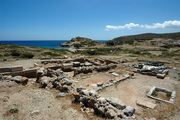 The emissaries on their arrival to Itanos met with a laver fisherman who recounted to them how he had once drifted away pushed by the wind to the land of Libya. In turn they convinced him to guide them there where they ended up funding the colony of Cyrene in 630 B.C. Itanos is also mentioned by Stephanos the Byzantine who reckons that the city's name finds its origins in the Itanos Phoenix. According to him, Itanos was a Phoenician colony controlling the laver and glass trade. It was in this city that the Phoenicians merchants, who traded with Crete, were based. Numerous laboratories for fish and laver processing, glass making and textiles were also found here. Itanos had always been a Syrio-Phoenician station where Phoenician gods such as Phoenix, Amfion and Tagha were worshiped. The city has been a very important port as it was used as a transportation base between the East and Crete.
The emissaries on their arrival to Itanos met with a laver fisherman who recounted to them how he had once drifted away pushed by the wind to the land of Libya. In turn they convinced him to guide them there where they ended up funding the colony of Cyrene in 630 B.C. Itanos is also mentioned by Stephanos the Byzantine who reckons that the city's name finds its origins in the Itanos Phoenix. According to him, Itanos was a Phoenician colony controlling the laver and glass trade. It was in this city that the Phoenicians merchants, who traded with Crete, were based. Numerous laboratories for fish and laver processing, glass making and textiles were also found here. Itanos had always been a Syrio-Phoenician station where Phoenician gods such as Phoenix, Amfion and Tagha were worshiped. The city has been a very important port as it was used as a transportation base between the East and Crete.
 Thanks the trade of laver, glass and fish, as well as the great income generated by the Diktaion Zeus temple, Itanos became a rich and prosperous city as one can infer by the great number of temples and luxurious marble structures that have been found here. Still, it was its affluence that led to their subjugation by the Dragmians who before rising up used to be controlled by the people of Itanos. Furthermore, when the Ierapytnians destroyed Praesos, Itanos was contained even further. After the Roman occupation of the whole island, Itanos managed to flourish thanks to seafaring and trade. The city minted its own currency that had the tridents, fish and even Triton (ancient eastern Cretan deity) as was to be expected by a seafaring city. Many of these coins are described by Sboronos. During the proto-Christian period, several glorious and gallant temples were erected as indicated by their ruins. Itanos was either destroyed in the 9th century A.D. by the Saracens or by the great earthquake in 795 A.D. The city must have been populated once more but was finally looted and utterly destroyed by pirates sometime during the 15th century. Its residents retreated to safer mountainous settlements.
Thanks the trade of laver, glass and fish, as well as the great income generated by the Diktaion Zeus temple, Itanos became a rich and prosperous city as one can infer by the great number of temples and luxurious marble structures that have been found here. Still, it was its affluence that led to their subjugation by the Dragmians who before rising up used to be controlled by the people of Itanos. Furthermore, when the Ierapytnians destroyed Praesos, Itanos was contained even further. After the Roman occupation of the whole island, Itanos managed to flourish thanks to seafaring and trade. The city minted its own currency that had the tridents, fish and even Triton (ancient eastern Cretan deity) as was to be expected by a seafaring city. Many of these coins are described by Sboronos. During the proto-Christian period, several glorious and gallant temples were erected as indicated by their ruins. Itanos was either destroyed in the 9th century A.D. by the Saracens or by the great earthquake in 795 A.D. The city must have been populated once more but was finally looted and utterly destroyed by pirates sometime during the 15th century. Its residents retreated to safer mountainous settlements.
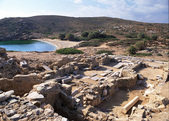 The regime of Itanos was initially monarchy but later became democratic with its own senate and open parliament ("ekklesia tou demou"). Sometime during the 3rd century B.C. there was an attempt to overthrow the aristocratic democracy. The citizens of Itanos asked for help by Ptolemy the Philadelphian of Egypt who sent the general Patroclus the Patron to their aid. In Itanos several sepulchral epigrams from the proto-Christian period have been found. On the transom of the Saint-John's temple one can find an epigram from the 3rd century B.C. describing how Itanios competed and equaled in archery the god of light and music, Apollo. In 1919 an old tomb was found, covered by two plaques that can be found in the Archaeological Museum of Heraklion. These plaques were made of locally extracted blue rock. The first epigraph comes from the 2nd century A.D. and consists of 98 verses badly damaged, that describe the conflict between the Itanians and the Ierapytnians over the Diktaeon sanctuary. The other epigraph contains a resolution from the 3rd century B.C. voted by the Itanians thanking the Macedonian general Patroclus the Patron. Itanos is also mentioned with the same name (u-ta-no) in the linear B inscriptions found in Knossos. In the area of Cape Sidero, the people sailing to the East worshipped the gods of the winds, that were later substituted by Poseidon.
The regime of Itanos was initially monarchy but later became democratic with its own senate and open parliament ("ekklesia tou demou"). Sometime during the 3rd century B.C. there was an attempt to overthrow the aristocratic democracy. The citizens of Itanos asked for help by Ptolemy the Philadelphian of Egypt who sent the general Patroclus the Patron to their aid. In Itanos several sepulchral epigrams from the proto-Christian period have been found. On the transom of the Saint-John's temple one can find an epigram from the 3rd century B.C. describing how Itanios competed and equaled in archery the god of light and music, Apollo. In 1919 an old tomb was found, covered by two plaques that can be found in the Archaeological Museum of Heraklion. These plaques were made of locally extracted blue rock. The first epigraph comes from the 2nd century A.D. and consists of 98 verses badly damaged, that describe the conflict between the Itanians and the Ierapytnians over the Diktaeon sanctuary. The other epigraph contains a resolution from the 3rd century B.C. voted by the Itanians thanking the Macedonian general Patroclus the Patron. Itanos is also mentioned with the same name (u-ta-no) in the linear B inscriptions found in Knossos. In the area of Cape Sidero, the people sailing to the East worshipped the gods of the winds, that were later substituted by Poseidon.




